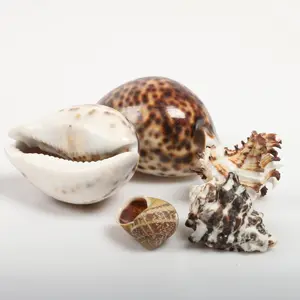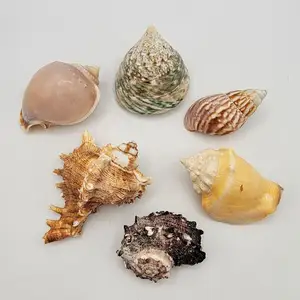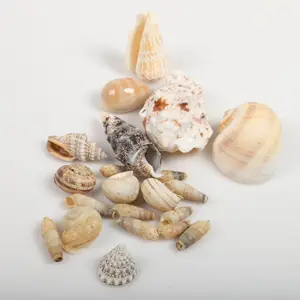(245 products available)





































































































































































































Trochus shells come in several types, each valued for its unique characteristics and differences. Below are some of the commonly known varieties:
Trochus cinerarius
The Trochus cinerarius, often known as the gray soldier's helmet, is a commonly found trochus shell in nature. This species can be found in a wide range of shallow marine habitats and coral reefs across the Indo-Pacific region. It has a rounded shape that resembles a military helmet as its name suggests. The shell's color ranges from gray to brown, often with lighter streaks. Some shells may also have a matte appearance or a slightly iridescent look. This moderately thick shell is durable and has a distinct trocas shape with prominent, curved ridges or whorls. These whorls run along the length of the shell and are often slightly spiny.Grey soldier's helmet is called trocas in Spanish, which means 'nail'. The name is associated with the spiny ridges on some variety of species, which resemble nails. This shell is commonly used for jewelry making, crafts, and decorative items, as well as being a source of trochus mother-of-pearl.
Trochus vulgaris
Trochus vulgaris, commonly known as the common trochus or the giant's stupa, is a widely distributed species of sea snail. This species is a type of marine gastropod. The shell of Trochus vulgaris is highly variable in color. It can range from white and cream to shades of brown, reddish-yellow, or even greenish. The shell may also sometimes have darker stripes or spirals. Common trochus shells can be found on coral reefs and rocky substrates across the Indo-Pacific region. They are particularly abundant in tropical areas. The trochus shell has a thick and sturdy shell that is essential for the snail's protection. The shape is characterized by its spiral, conical form. It has notable ridges or lines, called axial lirations, that extend horizontally across the shell.
Trochus niloticus
Trochus niloticus, commonly known as the Nile trochus or the Nile top shell, is a species of sea snail that is found in shallow marine environments. It can be found particularly around coral reefs and rocky areas in the Indo-Pacific region. The shell of Trochus niloticus is distinct and easily recognizable. It tends to be thick and conical, with a spiral that might resemble a top. The shells mostly range in color from white to pale, but they can also have darker shades of brown or green. Trochus niloticus has a strong and robust shell that protects it from predators. The species tends to have a characteristic helicoidal or spiral shape that is elongated compared to some other trochus species.
Trochus luhuanus
Trochus luhuanus, referred to as the rainbow trochus or Bridle trochus, is a type of sea snail that is commonly found in coral reefs across the Indo-Pacific region. It can be found especially in tropical areas. The shell of Trochus luhuanus is highly distinctive and variable. The shell's color can range from white to pink, reddish-brown, or even greenish, often with darker stripes or flecks. The patterns can be somewhat iridescent. Trochus luhuanus has a thick and sturdy shell which is essential in offering protection against predators. The spiral top of the shell is somewhat flattened compared to other species.
Trochus crispata
The Trochus crispata, commonly termed the "Spiny trochus," is primarily found in coral reefs, especially in the warmer tropical waters of the Indo-Pacific region. This species is known for its particularly spiny and rugged-looking shell. The shell is usually white to cream but can also possess shades of brown or reddish-brown. It has even some iridescent areas. Trochus crispata is fairly thick and can grow to about 7-8 cm in diameter although sizes can be variable. The spines or ridges on Trochus crispata's shell are more pronounced and spiny than other trochus species.
The Trochus shell has diverse design elements that make it both functional and aesthetically pleasing.
Shape
Trochus shells have a spiral or helicoidal form that sets them apart from other seashells. They appear like a miniature conical hat or a top. The shells look much more homogeneous from the outside than many other sea snail species.
The Trochus shells are usually quite convex or domed on the top with a whorl or spiral form that leads down to a flat base. This particular shape allows the animals to maneuver easily across rocky surfaces and coral in their habitats.
Color
Trochus shells are well-known for their striking color varieties. The shells can be in a wide range of colors that include white, cream, brown, reddish, and green. Some shells also have a more iridescent look. These appearances come from the inner layer of the shell that is formed from nacre.
Patterns
The patterns on the shell differ widely across trochus species. Some have simple and solid colors while others exhibit intricate and more detailed markings. These markings are such as stripes, spirals, or spots. The most common patterns on trochus shells are axial ribs or ridges. These are the ribs that run horizontally across the shells. Some species also have fine spiral lines, which are referred to as axials. These lines are nearly invisible when they are young but become more prominent with maturity.
Texture
The texture of trochus shells is rough compared to others due to the presence of ribs, spines, or granulations. These textures can be spiny or smooth depending on the species. The rough exterior provides protection against predators since it makes the shells harder to grasp.
Formations
Trochus shells are made up of calcium carbonate they excel in forming the characteristic spiral shape over millions of years. These shells evolve from the mantle tissue of the trochus snail. Their brilliant designs and styles are a result of both natural selection processes and the environmental habitats of the organisms.
Trochus shells can be used in several purposes. Below are some of their applications:
Home decoration
Trochus shell is a lovely and popular item that can be seen as a decorative piece in homes. Varieties like the Trochus cinerarius and Trochus niloticus have appealing aesthetic value due to their striking color and pattern combinations. They are thus displayed in shadow boxes, bowls, or as standalone pieces on shelves and mantels. The shells can be used to make wall art by arranging multiple shells into artistic patterns or designs. The shells can also be incorporated into other home decor items like picture frames or mirrors.
Jewelry making
Trochus shells are used to manufacture various jewelry items. The shells are cut into smaller pieces, polished, and then turned into earrings, pendants, bracelets, or rings. Trochus shell jewelry is loved for its natural, earthy look and is often found in bohemian or beach-themed jewelry collections.
Craft projects
Trochus shells are utilized in different types of craft activities. These crafts are beyond jewelry alone. The shells can be a part of mixed-media artworks or be painted and incorporated into creative projects. They are also a popular choice for educational crafts.
Scientific study and collections
Biologists and conchologists highly value Trochus shells for research purposes. The shells help in the understanding of biodiversity and the role of species in marine ecosystems. Trochus shells are commonly included in shell collections as they have unique shapes and patterns.
Traditional medicine and cultural uses
In some cultures, parts of Trochus shells have been used in traditional medicine. The mother-of-pearl from these shells was historically used to treat various ailments. The shells are also used in cultural practices. They are incorporated into rituals, talismans, and symbolic art.
Proper maintenance of Trochus shell products such as jewelry and decor is necessary to keep them looking their best.
Cleaning
A gently cleaning process is needed to maintain the Trochus shell. The shells should be cleaned using mild soap and lukewarm water to remove dirt, dust, and debris from the shell. It is advisable to avoid using harsh chemicals since they can damage or fade the shell's natural colors. A soft cloth can also be used to wipe the shell after it has been washed and let it air dry completely. This prevents any moisture-related damage.
Avoiding impact
Strong impacts should be prevented to avoid damaging the shells. It is advisable to store the shells in a soft-lined pouch or container. This helps shield them from accidental drops and collisions with hard surfaces. The wrapper should also be kept out of reach from children to prevent any unwanted breakage.
Storage
It is recommended to store Trochus shells in a cool, dry place. Avoid direct sunlight as it may lead to discoloration over time. For jewelry, ensure that each piece is stored separately to avoid tangling or scratching.
Humidity control
Maintaining the right moisture levels is good for the shells. Excess humidity can cause mold or bacteria growth. This is especially if the shell is being used for practical purposes. The environment should thus be kept dry and ideally at 40%-60% humidity. Conversely, very low humidity can lead to cracks. To avoid this, consider using a humidifier if the air tends to be too dry.
Handling
When handling Trochus shells, clean one’s hands to avoid transferring oil or dirt onto the shell. Hold the shell with care to avoid putting pressure on fragile parts. When moving the shell, be gentle to prevent any unintended breaks or cracks from forming.
Regular inspections
It is always recommended to inspect the Trochus shell products periodically. Look for signs of wear, damage, or weakening. This helps in enabling timely repairs or replacements as needed.
Trochus shells and their meat are edible but are not commonly used for food due to very tough and chewy meat. However, they may require thorough preparation in order to be digestible. In contrast, the trochus shell is commonly used around the world for diverse purposes suches as jewelry making, crafts, and decorations. The shells may also be valuable for producing mother-of-pearl.
Trochus spp are not considered rare. They can be found in diverse marine environments across numerous regions. They are located particularly in the Indo-Pacific waters. The shells may however be sometimes perceived as rare due to their unique design and patterns. Some come in color variants in their species. These characteristics make them highly valued and sought after for decorative purposes and jewelry making. The shells can however occasionally be endangered when overexploited.
Not all trochus shells have spines. The presence or absence of spines depends on the species of trochus. Some have spiny projections, while others have smooth or slightly wavy surfaces.
Making an identification of a trochus shell as real can be done by examining its texture, weight, and patterns among others. Authentic shells have slight irregularities. They are natural materials that are not perfectly manufactured. The shell is usually much heavier than synthetic alternatives. A genuine trochus shell shows varying colors throughout its structure. These colors are not limited to the surface alone. The part that resembles a nacre has a lustrous inner layer that is formed from mother of pearl. This trait cannot be replicated in artificial shells. Genuine shells generally display a uniform pattern. No two constructed patterns will look alike each other.